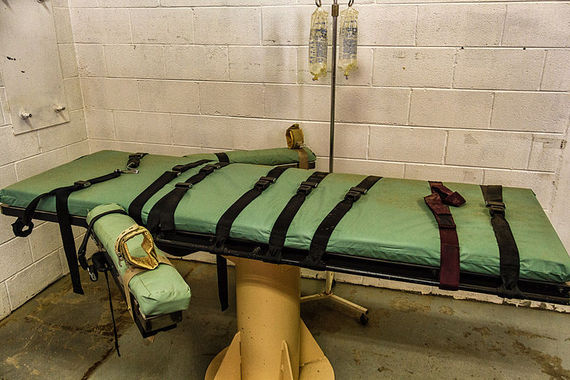
Since a moratorium on capital punishment was lifted in 1976, the United States of America has executed 1,440 death row inmates. The majority of these executions have been carried out using 1, 2 or 3-drug lethal injection protocols. In 2016 alone, 18 prisoners in America have been executed in this way.
Lethal injection, as a means to carry out such state-sanctioned executions, was first proposed nearly 40 years ago by Jay Chapman, Oklahoma's state medical examiner. Following public pressure to abandon the use of electrocution in capital punishment, Chapman's idea spread across the country and capital punishment, through its new association with medicine, once again became respectable.
Following its adoption, the standard lethal injection protocol included the use of three fast acting drugs administered intravenously in the inmate's arm. The first, sodium thiopental, acts as a sedative and relaxes the prisoner. Next, a paralytic agent is administered to inhibit skeletal muscle contraction, paralyzing the inmate. Finally, an injection of potassium chloride is administered to induce cardiac arrest, killing the inmate.
Of these drugs, the most controversial remains the paralytic agent, which effectively serves as a behavioral mask during the execution protocol. The use of this drug has led some medical professionals to refer to the lethal injection process as a sort of theatre: "the curtain goes up, the curtain goes down". With the employment of a paralyzing agent, onlookers are saved the trouble of witnessing an untidy execution in which inmates may convulse or twitch. But as has been noted elsewhere, the use of the paralytic, from the perspective of the inmate, is indeed bizarre as it offers a more human-seeming execution but allows for the possibility, quite literally in this case, of unspeakable pain and suffering.
Recently, controversy related to access to lethal injection drugs in America has gained much attention. The European Union, in addition to drug manufacturers, has blocked American access to their products for use in the execution of inmates. In response to these shortages, some states have begun to discard the 3-drug protocol described above in place of a 1-drug protocol whereby a massive dose of a powerful barbiturate is administered to kill the inmate. In other instances the use of midazolam as the first drug in the 3-drug protocol has sparked debate and controversy. These haphazard approaches, along with a number of cruel and unusual executions, have thrust the constitutionality of lethal injection practices back into the spotlight. In the wake of these horrendous cases, one is left to wonder to what length such states will go to in order to carry out the backward and unethical laws related to lethal injection.
Indeed society's view of the practice of electrocution as being barbaric certainly influenced the original moratorium and inception and widespread adoption of lethal injection in the 1970's. Unfortunately, as we've come to clearly observe in recent years, the currently accepted practices have done little to satisfy the barbarity question. In the 21st century, there is simply no role for medicine in the torture chambers that are America's execution chambers- we can and must do better. The rest of the civilized world gets this. It's now time for American society and indeed medical culture to get it and resist continuing the regrettable practice of lethal injection.
